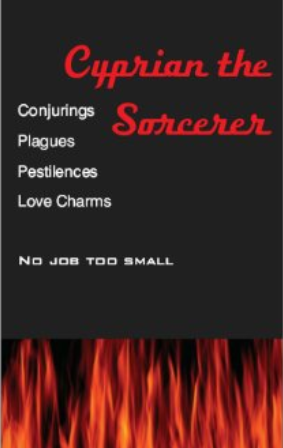Just in time for Halloween, this month’s saint was a real charmer. Literally. Don’t get him mixed up with the other, famous, respectable St. Cyprian who was once bishop of Carthage and is now mentioned in the Mass. This is the other one. The one who went around conjuring up Satan.
Cyprian was born in Antioch of devout pagan parents. It was their dearest wish to someday see their son grow up to be a priest, so they dedicated him to the gods when he was a mere lad of 7. Cyprian took to pagan ministry. He studied at the best schools of witchcraft, one in Babylon, one in Egypt, and a few in Greece. He mastered this secret knowledge and became an expert at casting spells. Then he taught it to others, corrupting as many souls as he could. Soon he became highly sought after. If you needed revenge on your enemies or success in love or to speak to your dead grandmother you called:

One day a youth named Agleides hired Cyprian to cast a love charm on the beautiful virgin, Justinia. He had proposed marriage already but she claimed she was already taken. She had consecrated herself to Jesus Christ.
It was a small job to Cyprian but it was to change everything.
He did not know who he was dealing with. Justinia was a nun. Her prayers and fasting had already won her own parents over to Christianity and she was now dedicating her life to the conversion of all the other pagans around her. Like Cyprian she was determined to take as many souls into the afterlife with her as she could.
He started with the usual trick, trying to arouse the young woman to desires of the flesh. That failed miserably so he turned the magic up to 11 and assumed a terrifying demonic form.
Justinia fought back by making a simple sign of the cross.
To a man so steeped in the occult that he had once beheld Satan himself, this must have looked like a new form of sorcery. Cyprian attempted to summon plague and pestilence upon Justinia’s family but again, the sign of the cross prevented it. Cyprian then turned to Satan and mocked him for being afraid of the mere mention of the cross.
“What will you do when Christ himself stands before you?”
Satan turned on his favorite and unleashed the full power of his rage. He beat him and choked him. Cyprian turned to the only one who had power over the devil — Jesus Christ. He alone could save him. He made the sign of the cross.
Then it was over. After 30 years in Satan’s service, Cyprian was free.
He burned his books of sorcery, took sanctuary in a church, and was hard put to leave the premises ever again. After the local bishop baptized him, he went forth and began a life of reparation. He converted so many pagans that the temples stood empty. Justinia became the head of her order and supported him with her prayers and fasting.
In the year 304, the two were martyred under Diocletian. Cyprian is said to have stalled so that Justinia could go first. He didn’t want her to be terrified by seeing him die. In this way, perhaps he made up for the terror he put her through on that fateful day.
If you should ever come across a copy of the Book of St. Cyprian, you might wish to do as St. Cyprian would and burn it. It is a textbook of spells published in Spanish or Portuguese in the 19th century which contain a weird mixture of Catholicism, superstition, and witchcraft. He would be horrified. If there is one lesson we can learn from his life, it is that Satan is no spirit to be trifled with. There are no small spells.
What the life of St. Cyprian also shows is that you are never too far gone that God cannot redeem you.
Often we see saints who did evil in their past such as stealing, adultery, and murder. Cyprian did all of that plus the ultimate evil: He sold his own soul. Yet the prayers of a holy nun and the simple sign of the cross were enough to convert him.
This article appeared on the Catholic Digest blog, October 2018, as part of series about Eastern Rite saints called: Saints with Funny Names. St. Cyprian’s feast day on the Eastern Catholic calendar is October 2.
This Article is reproduced with the permission of Bayard, Inc. Reproduction of this material, in any form, requires the written permission of Bayard Inc.